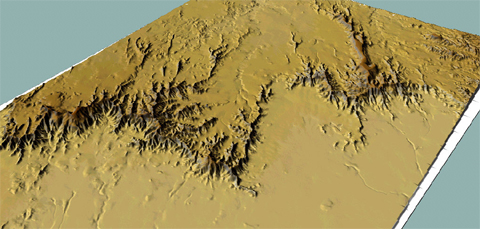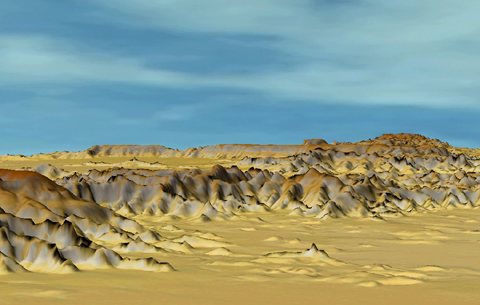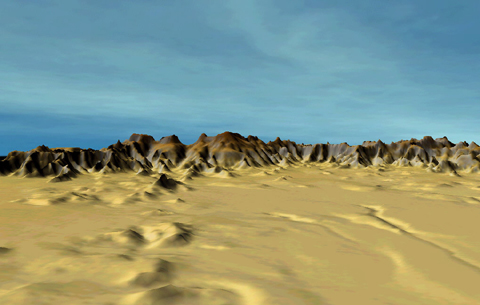Across the high plains of the United States, sedimentary strata ranging in
age from Cretaceous to Tertiary were deposited in a shallow epicontinental
seaway in extensive horizontal layers. These strata are generally composed
of fine sandstone, siltstone, shale, and volcanic ash and are very easily eroded.
 <a onClick="window.open('/olcweb/cgi/pluginpop.cgi?it=jpg:: ::/sites/dl/free/0072402466/30425/VirtualVista0501.jpg','popWin', 'width=NaN,height=NaN,resizable,scrollbars');" href="#"><img valign="absmiddle" height="16" width="16" border="0" src="/olcweb/styles/shared/linkicons/image.gif"> (131.0K)</a>
<a onClick="window.open('/olcweb/cgi/pluginpop.cgi?it=jpg:: ::/sites/dl/free/0072402466/30425/VirtualVista0501.jpg','popWin', 'width=NaN,height=NaN,resizable,scrollbars');" href="#"><img valign="absmiddle" height="16" width="16" border="0" src="/olcweb/styles/shared/linkicons/image.gif"> (131.0K)</a>
Stream incision into these loosely consolidated deposits combined with effects
of weathering and erosion resulted in formation of "badlands" -
a highly irregular landform composed of complex gullies with little or no
soil or vegetation.
 <a onClick="window.open('/olcweb/cgi/pluginpop.cgi?it=jpg:: ::/sites/dl/free/0072402466/30425/VirtualVista0503.jpg','popWin', 'width=NaN,height=NaN,resizable,scrollbars');" href="#"><img valign="absmiddle" height="16" width="16" border="0" src="/olcweb/styles/shared/linkicons/image.gif"> (130.0K)</a>
<a onClick="window.open('/olcweb/cgi/pluginpop.cgi?it=jpg:: ::/sites/dl/free/0072402466/30425/VirtualVista0503.jpg','popWin', 'width=NaN,height=NaN,resizable,scrollbars');" href="#"><img valign="absmiddle" height="16" width="16" border="0" src="/olcweb/styles/shared/linkicons/image.gif"> (130.0K)</a>
At Badlands National Park in South Dakota, USA, this landform is very well
developed in sedimentary strata from the Tertiary Period, as these Virtual Vistas illustrate. The exposed bluffs of semi-consolidated
sedimentary materials are continually changing as wind and water sculpt the
land surface.
Erosion is so efficient, no soil forms on the exposed slopes, and vegetation
cannot gain a foothold in the crumbling debris. The lack of vegetation enhances
the efficiency of wind and water erosion in this landscape.
 <a onClick="window.open('/olcweb/cgi/pluginpop.cgi?it=jpg:: ::/sites/dl/free/0072402466/30425/VirtualVista0504.jpg','popWin', 'width=NaN,height=NaN,resizable,scrollbars');" href="#"><img valign="absmiddle" height="16" width="16" border="0" src="/olcweb/styles/shared/linkicons/image.gif"> (107.0K)</a>
<a onClick="window.open('/olcweb/cgi/pluginpop.cgi?it=jpg:: ::/sites/dl/free/0072402466/30425/VirtualVista0504.jpg','popWin', 'width=NaN,height=NaN,resizable,scrollbars');" href="#"><img valign="absmiddle" height="16" width="16" border="0" src="/olcweb/styles/shared/linkicons/image.gif"> (107.0K)</a>
To learn more about Badlands National Park, visit the National
Park Service website.

